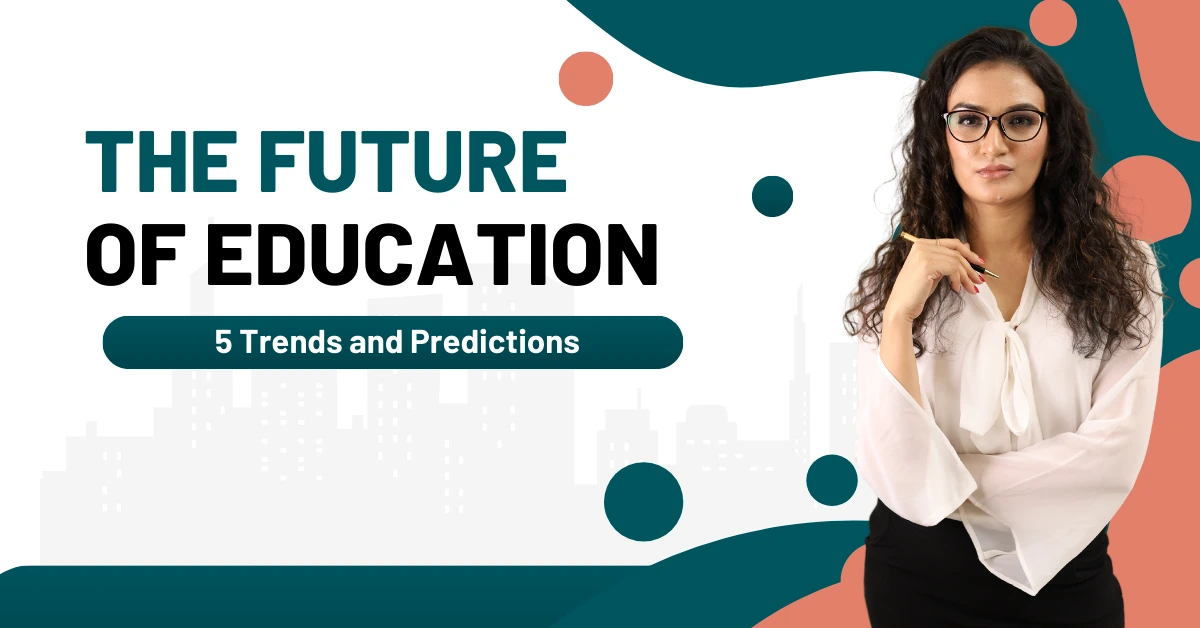
The Future of Education: 5 Trends and Predictions
- 80
- 0
- 0
The future of education is about making learning more flexible, personalized, and accessible to everyone. Technology, like virtual classrooms and interactive learning tools, will let students learn at their own pace and style, anytime and anywhere. Skills like problem-solving, creativity, and digital literacy will become more important than ever, preparing students for a world that’s always changing. Teachers will be guides and mentors, helping students connect what they learn to real-world challenges. Education will focus not just on academics, but on personal growth and well-being, creating learners who are adaptable, curious, and ready for the future.
The Future of Education: 5 Trends and Predictions
Education is changing fast. New technology, different ways of teaching, and changes in how we work are making schools and learning look very different from what they used to be. Let’s look at the future of education and the five big trends that will shape how we learn in the coming years.
Personal Learning Paths
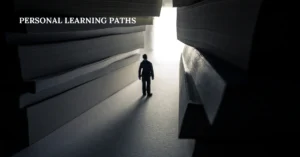
Personal education paths permit students to understand in their way, at their speed. By focusing on individual strengths and interests, this approach helps each student stay motivated, develop confidence, and achieve their personal learning goals.
Gone are the days when every student had to learn the same things at the same time. Schools are now moving toward personalized learning, where each student can learn at their speed and in ways that work best for them.
What this means:
- Students can pick subjects they’re interested in
- Computer programs help track how well students understand topics
- Teachers can give extra help where needed
- Students who learn faster can move ahead, while others get more time and support
- Learning plans that match each student’s goals
For example, if one student is great at math but needs help with reading, they can work at an advanced level in math while getting extra support in reading. This helps every student succeed in their way.
Virtual and Mixed Reality Classrooms
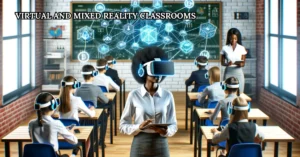
Virtual and Mixed Reality Classrooms use 3D technology to bring learning to life. Students can explore places, objects, and even historical events in a virtual space, making lessons exciting, interactive, and easier to understand from anywhere in the world.
Virtual reality (VR) and mixed reality are changing how students learn. Instead of just reading about things in books, students can see and interact with them in 3D.
How this helps:
- History students can walk through ancient Rome
- Science students can see inside a human cell
- Geography students can visit different countries
- Medical students can practice operations safely
- Engineering students can create and test virtual devices
These technologies make learning more fun and help students remember things better because they can see and do, not just read and listen.
AI Teachers and Tutors
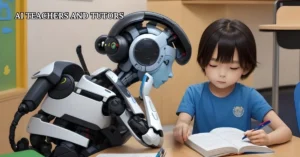
AI teachers and tutors bring smart, helpful learning to students. They answer questions anytime, offer personalized lessons, and help students learn at their speed. With AI guidance, students gain confidence, improve skills, and enjoy studying more.
Artificial Intelligence (AI) is becoming a big assistant in instruction. While AI won’t replace human teachers, it will help them do their jobs better and give students extra support.
What AI brings to education:
- 24/7 homework help
- Quick answers to common questions
- Practice problems that adjust to student levels
- Checking work and giving feedback fast
- Spotting when students need extra help
- Helping teachers plan lessons
Think of AI as a teaching assistant that never gets tired and can help many students at once. This gives teachers more time to work one-on-one with students who need it most.
Project-Based Learning Takes Over
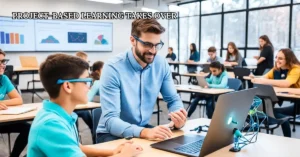
Project-based learning is becoming popular in education. It lets students learn by working on real projects, building practical skills, and encouraging creativity. This hands-on approach makes learning more engaging, helping students understand topics better and solve real-world problems.
Schools are moving away from just memorizing facts. Instead, they’re focusing on projects that solve real problems. This helps students learn skills they’ll need in their jobs.
What students learn through projects:
- How to work in teams
- Problem-solving skills
- Time management
- How to present ideas
- Real-world job skills
- How to utilize what they understand in real life
For instance, instead of just learning about pollution in science class, students might work on a project to reduce waste in their school. This creates understanding more expressive and fun.
Learning Anywhere, Anytime

Learn anywhere, anytime! With online education, teaching fits right into your life. Whether you’re at home, on the go, or have a busy schedule, you can easily access courses and grow your skills whenever it suits you.
The idea that learning only happens in school buildings from 8 AM to 3 PM is changing. The future of education is flexible and happens everywhere.
What this looks like:
- Online classes you can take from home
- Learning apps on phones and tablets
- Video lessons you can watch anytime
- Online study groups with students from other countries
- Classes that mix online and in-person learning
- Learning while traveling or working
This flexibility helps people learn while managing work, family, and other responsibilities. It also means you can keep learning throughout your life, not just when you’re young.
What These Changes Mean for Students
These new trends in education will help students in many ways:
- Memorize in ways that perform best for them
- Study at their speed
- Get help when they need it
- Learn skills for future jobs
- Stay interested and excited about learning
- Connect with other students worldwide
- Keep learning throughout their lives
What These Changes Mean for Teachers
Teachers’ roles will change too:
- More time helping individual students
- Less time grading papers (AI helps with this)
- New ways to teach using technology
- More focus on life skills and problem-solving
- Better tools to track student progress
- More time to be creative with lessons
Getting Ready for the Future
While these changes are exciting, they also mean we need to prepare:
- Schools need good internet and computers
- Teachers need training in new technology
- Students need basic computer skills
- Schools need money for new tools and programs
- Everyone needs to be open to new ways of learning
Final Thoughts
The future of education looks very different from what we know today. But these changes will help make learning better for everyone. Students will learn more easily, teachers can help more effectively, and everyone can keep learning throughout their lives.
The most important thing to remember is that these changes aim to make learning work better for each person. Whether you’re a student, teacher, or parent, the future of education has something good in store for you.
This is an exciting time for education. As these trends grow and new ones appear, we’ll keep finding better ways to learn and teach. The key is to stay open to these changes and ready to learn in new ways.
FAQs
What is the future of online learning?
Online learning will keep growing, making education more accessible for everyone. It allows people to study from anywhere, at any time, providing flexibility and reaching students around the world.
How will technology affect classrooms?
Technology will bring interactive devices like virtual reality and AI into classrooms. These tools help students understand topics better and make learning more exciting and hands-on, preparing them for future careers.
Will personalized learning become common?
Yes, personalized learning is expected to grow. It means lessons are tailored to each student’s strengths, weaknesses, and pace, helping them learn more effectively and feel more engaged in their education.
Is skills-focused learning the future?
Definitely. Education will focus more on skills needed for real jobs. Schools and colleges will teach problem-solving, communication, and tech skills, preparing students to succeed in the modern job market.
Will global collaboration be part of future learning?
Yes, global learning networks will connect students worldwide. Working with peers from different countries will help students understand diverse perspectives, improve teamwork, and prepare them for a connected world.
Also Read:
Top 10 Educational Apps for Students
References:
https://en.wikipedia.org/wiki/Futures_of_Education
https://en.wikipedia.org/wiki/Education
https://www.unesco.org/en/futures-education
Disclaimer:
The trends and predictions outlined in “The Future of Education: 5 Trends and Predictions” are based on current research and expert opinions. These insights are speculative and may evolve as technology and educational practices continue to change.
Related post

7 Health Benefits of Assam Tea


